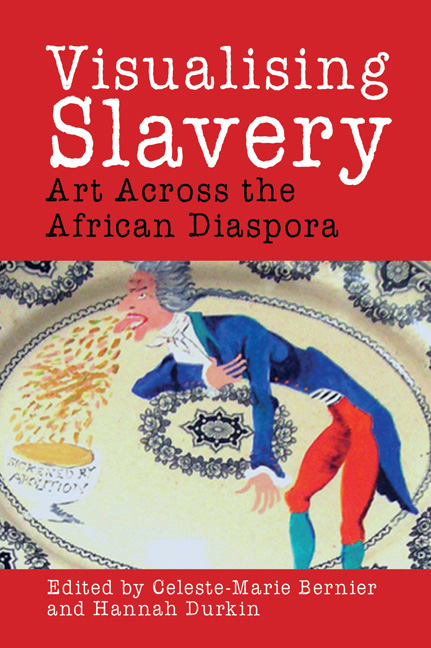Book contents
- Frontmatter
- Dedication
- Contents
- List of Illustrations
- Acknowledgements
- Introduction: ‘Inside the Invisible’: African Diasporic Artists Visualise Transatlantic Slavery
- Part I Slavery and Memory in Contemporary African Diasporic Art
- Part II Historical Iconography and Visualising Transatlantic Slavery
- Part III African Diasporic Monuments and Memorialisation
- Part IV Contemporary Legacies in African Diasporic Art
- Chapter 13 We Might Not Be Surprised: Visualising Slavery and the Slave Ship in the Works of Charles Campbell and Mary Evans
- Chapter 14 ‘X is for X Ray, X Slave, X Colony’: A ‘Lexicon of Liberation’ versus ‘My Slave History’ in the Paintings, Installations and Sketchbooks of Donald Rodney
- Chapter 15 Reconfiguring African Trade Beads: The Most Beautiful, Bountiful and Marginalised Sculptural Legacy to Have Survived the Middle Passage
- Afterword: Against the Grain: Contingency and Found Objects
- Notes on Contributors
- Index
- Platesection
Chapter 14 - ‘X is for X Ray, X Slave, X Colony’: A ‘Lexicon of Liberation’ versus ‘My Slave History’ in the Paintings, Installations and Sketchbooks of Donald Rodney
from Part IV - Contemporary Legacies in African Diasporic Art
- Frontmatter
- Dedication
- Contents
- List of Illustrations
- Acknowledgements
- Introduction: ‘Inside the Invisible’: African Diasporic Artists Visualise Transatlantic Slavery
- Part I Slavery and Memory in Contemporary African Diasporic Art
- Part II Historical Iconography and Visualising Transatlantic Slavery
- Part III African Diasporic Monuments and Memorialisation
- Part IV Contemporary Legacies in African Diasporic Art
- Chapter 13 We Might Not Be Surprised: Visualising Slavery and the Slave Ship in the Works of Charles Campbell and Mary Evans
- Chapter 14 ‘X is for X Ray, X Slave, X Colony’: A ‘Lexicon of Liberation’ versus ‘My Slave History’ in the Paintings, Installations and Sketchbooks of Donald Rodney
- Chapter 15 Reconfiguring African Trade Beads: The Most Beautiful, Bountiful and Marginalised Sculptural Legacy to Have Survived the Middle Passage
- Afterword: Against the Grain: Contingency and Found Objects
- Notes on Contributors
- Index
- Platesection
Summary
‘I was in hospital again and during the injection of Maximum dose pethadine to kill the pain I drifted off to a landscape Nightmare. I flo[a]ted above everything [on] a sea of glass on which sailed a boat filled with slaves but somehow we were connected by blood and bone and flesh and storms raged’, so Black British artist Donald Rodney writes in Sketchbook No. 17 dated 1987. Surviving as a source of physical, psychological and imaginative wounding no less than of myth, memory and trauma, the history of transatlantic slavery remains the defining catalyst of Rodney's life and work. Dramatically to the fore in his powerful ‘landscape Nightmare’ is his artistic fight against the dominant forces of amnesia and censorship embedded within white national memory and public histories of slavery, which has remained indelibly intertwined with his lifelong struggle against personal suffering. His vision of the ‘blood and bone and flesh’ of the slave ship stands as a powerful metonymic signifier of the ‘storms’ that ‘raged’ against his own body following his hospitalisation and exposure to medication provided to ‘kill the pain’ of a ‘CRISIS: The name given to a Sickle Cell attack’ as he fought the body-and-soul-destroying effects of ‘a blood disorder, that I and many other black people suffer from’. As situated against the powerful backdrop of a history of transatlantic slavery that resulted in a Black holocaust generating genocide on an unimaginable and seemingly un-image-able scale, Rodney's diagnosis with sickle cell anaemia, which he identified as a ‘Black Disorder’ – on the grounds that this disease primarily afflicted Black peoples throughout the African diaspora and continues to be subjected to gross neglect in inferior levels of research funding and medical support – provides poignant confirmation of the enduring legal, political, historical, cultural, philosophical and ideological stranglehold of white racism in the late twentieth century. According to Rodney, the history of transatlantic slavery resonated as a centuries-long institution that experienced a powerful afterlife by generating legacies that remained imbued with white Westernised constructions of Black bodies as a source of disease, illness, pollution, corruption, criminalisation and parasitical invasion not solely within a national body politic, as defined by white supremacist policies but, and more damningly, within the highly charged terrain of a Western art history configured as for whites only.
- Type
- Chapter
- Information
- Visualising SlaveryArt Across the African Diaspora, pp. 218 - 247Publisher: Liverpool University PressPrint publication year: 2016

